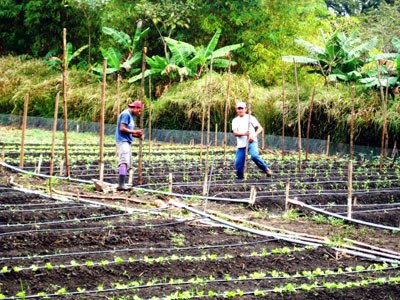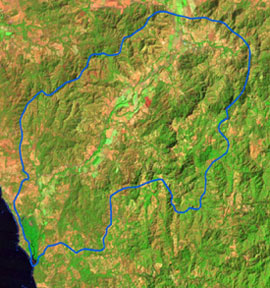Restoring a River Valley
One Business at a Time
Over the years, Gardener's Supply has successfully incubated and supported a number of complementary enterprises with improve-the-earth-through-business missions. Close to home, these have included Vermont's first and now largest community composting facility, and its first and largest community-supported farm (now providing organic produce, eggs, cheese and meat to more than 1,000 people each week of the growing season). In support of these and other local initiatives, we also founded the Intervale Center, which is now an internationally recognized nonprofit organization promoting sustainable farming and local food production.
 Eber and Jose prepare tomato trellising in a sunken bed at Finca Lagunita. The bed is surrounded by perennial fruit trees and protected with iguana fencing.
Eber and Jose prepare tomato trellising in a sunken bed at Finca Lagunita. The bed is surrounded by perennial fruit trees and protected with iguana fencing.It was about ten years ago that I began wondering if this approach to building linked, values-based enterprises that yield a more sustainable economy could work in a less-receptive and less-developed setting than Vermont's. In 2000 I decided to begin working on this question in Costa Rica where my wife's relatives live. What we've found is that our vision of working to support local agriculture has had to adapt to the local realities and opportunities in Guanacaste, the northwestern province in Costa Rica that we now call our home away from home.
Guanacaste is like a lot of rural areas in Latin America where age-old patterns of self-sufficiency have given way to export crop monocultures, massive deforestation for cattle and most recently a change to a tourism-based economy. We spent the first three years learning about the interaction between these local and global economic forces. Our learning was accelerated by several university-level courses that I developed, which engaged Costa Rican and U.S. professors and students, plus local residents, to consider challenges and opportunities for building a more sustainable local economy. We concluded that the best strategy for building a stronger local economy should focus on restoring local ecological health through community engagement and by developing enterprises congruent with this mission.
 |
| Satellite photo shows the 25,000-acre Rio Nandamojo watershed. flowing into the Pacific. The image reveals a decrease in forest and plant cover. |
The long-term effects of deforestation led to a "drying out" of the Nandamojo river valley where we live. Our watershed restoration efforts, referred to as Greening Paraiso, are inspired by the vision of a village matriarch who implored us to ?make the river flow again.? With funding from the U.S. Fish & Wildlife Service, we have documented the rich migratory bird population in this area, and have helped increase community awareness of the need for reforestation, water and habitat protection and local food production.
Greening Paraiso has also spawned two conservation developments, Tierra Pacifica and Pueblo Verde. Tierra Pacifica pioneered efforts at rainwater management and erosion control, techniques and know-how that have now been applied on dozens of homes and projects in the area. Tierra Pacifica also provided a springboard for reinvigorating local agriculture by providing land for the farm we?ve named Finca Lagunita .
Finca Lagunita, our first effort to spark a renewal and diversification of local farming, is actually trying to accomplish several things at once. The Farm's motto is "Recordando el pasado, sembrando el futuro" (Remembering the past, sowing the future). We are growing traditional crops for the local market, including corn, beans, rice, squash and plantain. We've also introduced new crops that appeal to the local expatriot market (such as cherry tomatoes and heat-tolerant greens), and new techniques for dealing with the low fertility, soil erosion and runoff issues that plague our area (such as composting and converting abundant wet-season plant residue into biochar as a long-lived soil amendment). The weather problems in Guanacaste are more severe than they are in Vermont (heat, intense sun, wind, no rain/too much rain). Plus we have some new challenges, like monkeys eating the papayas, and iguanas grazing on our baby tomatoes and stray rodeo bulls busting up the shade houses. Among our biggest issues is synchronizing production with the peaks in local demand for farm produce during the ups and downs of the tourist seasons.
One thing we have confirmed with Finca Lagunita is that -- much like in the States -- there is a growing enthusiasm among both new home buyers and established local residents, to know where their food is produced, to have personal contact with the growers and to feel the security that some part of their diet is coming from "close to home". Finca Lagunita also plays a role in the broader watershed goals, as its sunken beds, designed for wind protection and efficient watering in the dry season, are a major water harvesting trap and refuge for aquatic birds in the rainy season. As well, the farm infrastructure and staff allows us to produce thousands of native plants that are made available for erosion control and habitat restoration.
Pueblo Verde takes the lessons and techniques we've learned from Tierra Pacifica and Finca Lagunita to a higher level. With Pueblo Verde we have designed a 15-lot development with some audacious goals for a residential development that addresses a number of local issues and problems:
- Can we restore a monoculture reforestation project to a diversified dry tropical forest that emphasizes native tree crops, healthy habitat and sustainable production of wood?
- Can we create a "forest farm village" with a large percent of the land dedicated to fruit and vegetable growing?
- Can we help restore hydrology of our watershed by retaining the maximum possible amount of the rainwater on site while reusing and conserving water during the six-month dry season?
- Can we integrate locals into the project ("don't gate, integrate"), providing a wide range of housing, plus jobs?
- Can housing fit the climate and be energy efficient using local materials as much as possible?
The Nandamojo watershed is a rural area with few centers of commercial activity, serving the dispersed communities. So, we have recently opened Mi Tierra Nursery and Garden Center and will soon open Tierra Pacifica Commercial Center to provide high-visibility commercial venues where local produce, plants and other products can benefit from greater exposure. Mi Tierra offers food plants and trees, gardening supplies, locally produced food as well as ornamental plants. The Mi Tierra store and grounds provide ongoing environmental outreach on the importance of a healthy watershed and show practical examples of what can be done on the home, farm or development scale in order to contribute to improving our area.
The Tierra Pacifica Commercial Center will be the first multi-store commercial complex in the region. The anchor tenant will be a mini-supermarket offering produce, meat, milk, cheese and eggs from Finca Lagunita and other local producers. Like Mi Tierra, this Commercial Center will also be a gathering place where we can educate about efforts to improve communities and restore the environment.
The Rio Nandamojo is not yet flowing year-round. But with each tree we help plant, each farm and house that captures and retains rainwater, and each business that strengthens the local economy while promoting environmental stewardship we are getting closer to achieving this goal.
Last updated: 02/14/2024
Print this Article:
Related Articles
Get the Dirt
Stay up to date on new articles and advice. Please fill out the information below.



